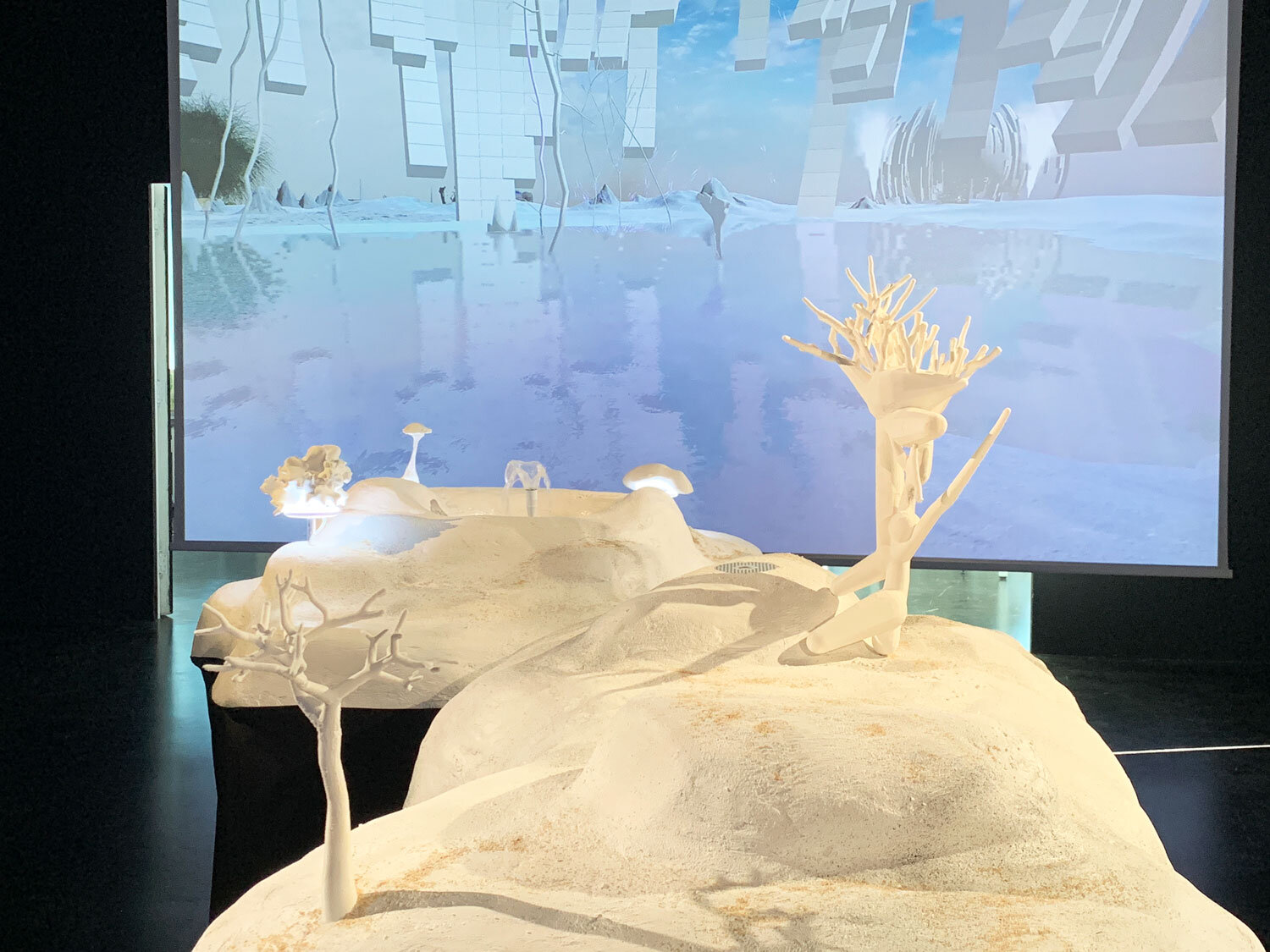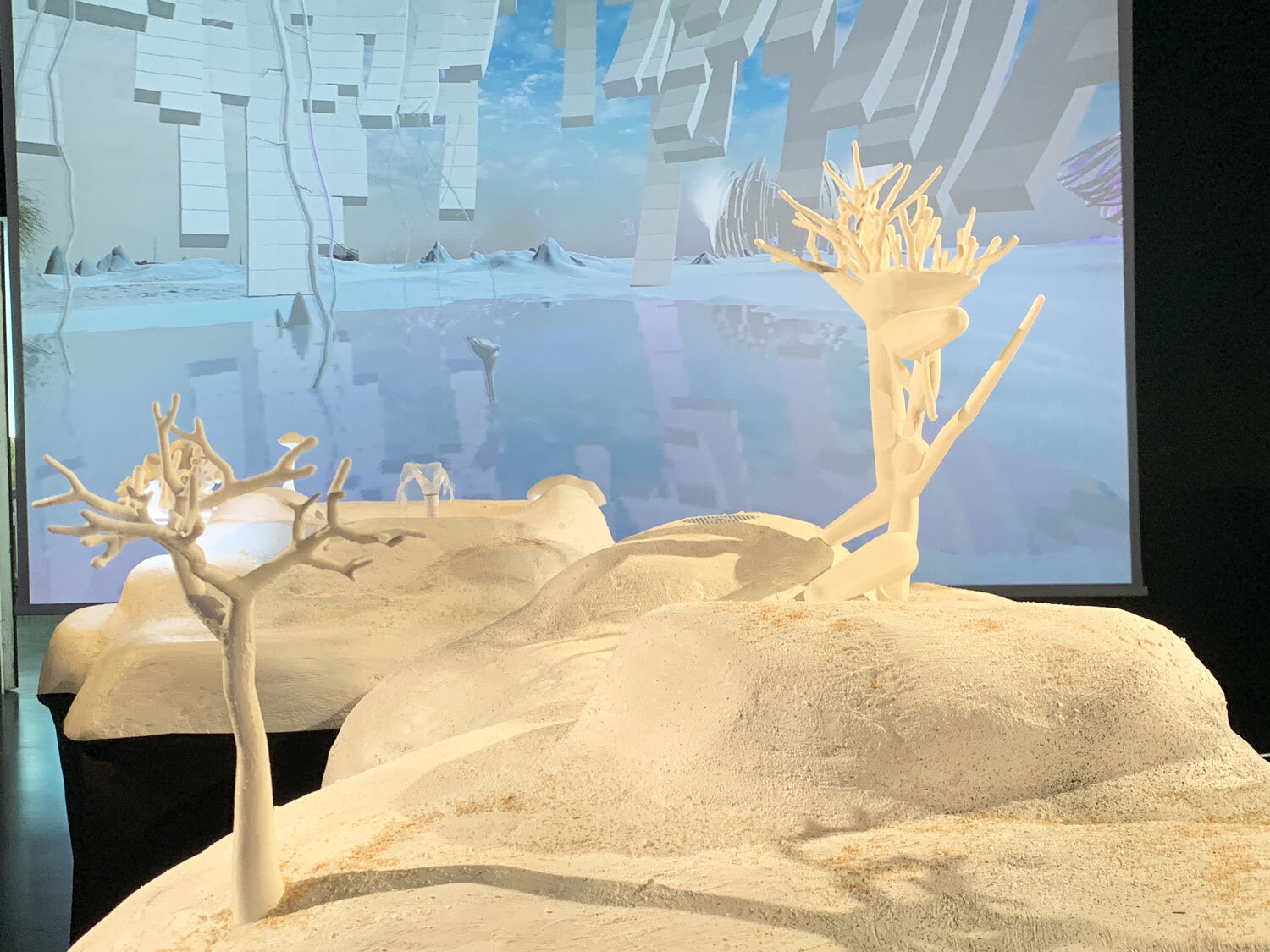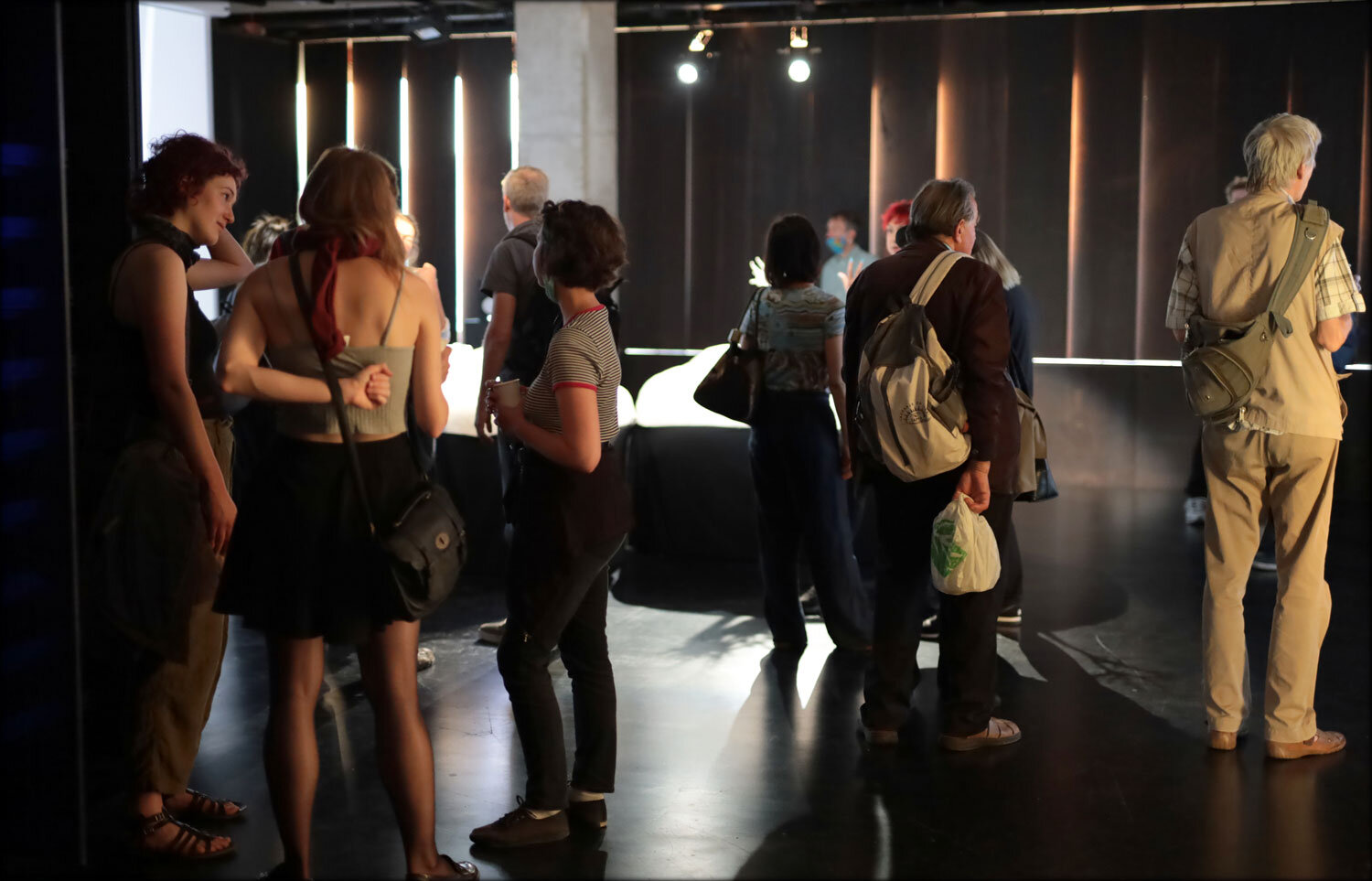Island
Sphere3 Island
Sculpture
Sand, plasma-treated water, electronics, plexiglass, metals, 3D prints, LED lights, titanium substrate plates
3D modelling: Tanja Vujinović
Executive production: Tanja Vujinović, Jan Kušej
Objects hardware, assembly: Jože Zajec, ScenArt
3D printing: Tomo Per, RogLab
Hardware device development: Dr Luka Suhadolnik, Department for Nanostructured Materials, Jožef Stefan Institute
Programming and custom-made electronics: Dr Vid Podpečan, Department of Knowledge Technologies, Institute Jozef Stefan
Coproduction: SciArtLab, Institute Jozef Stefan
Photographic documentation: Ultramono, Sunčan Patrick Stone, Miha Fras
Production: Ultramono, 2020
Consulting
Jan Kušej, Ultramono Institute
Dr Jelena Guga, researcher
Tomo Per, RogLab
Jože Zajec, ScenArt
Dr Vid Podpečan, Department of Knowledge Technologies, Institute Jozef Stefan
Dr Luka Suhadolnik, Department of Nanostructured materials, Jožef Stefan Institute
Arijana Filipić, Department of Biotechnology and Systems Biology, National Institute of Biology
Derek Snyder, researcher and editor
Sculpture Sphere3 Island, part of the AvantGarden series, is an invitation to think about the ecologies of the world and the networks we are part of. This futuristic synthetic biosphere, is the place of the possible, the actual, and their mutual interplay. It is a physical installation whose elements are derived from the virtual environments of the AvantGarden.
Elements of the installation – fountain, different materials and synthetic plants as instruments – are inspired by the science of nano-structured materials, artificial intelligence and plasma physics. Some objects within the installation contain nanotubes grown on titanium plates which serve as a protective boundary that filters air. One of the synthetic plants is based on research of the impact that specific sound wavelengths have on the human brain, as well as on our mood, emotions and well-being. It captures the voices of gallery visitors, analyses them using a trained deep neural network, and generates a monoaural sound that subtly affects the visitors. Water within the central fountain is conditioned by plasma (just like the water hit by lightning); it is water whose chemistry has been changed. Such processes in nature might provoke "butterfly effect" changes that continue to ripple through entire ecosystems. Drawing from biomimetics and the Internet of Things, the individual units within the installation transform vibration into other types of energy and data, thus affecting their environment.
Water is crucial to all living things and processes on Earth, as an omnipresent carrier and base. Mythological stories related to gardens often revolve around the central water source, which supplies all life in the vicinity. Gardens, parks, natural reserves all relate to the symbolic and actual importance of the presence and sustainability of water. Both classical Greek philosophy and traditional Chinese philosophy, among others, devised theories about how water affects everything, how it emerges and shapes the Earth and all living systems. The pastoral garden, with abundant water, belongs to the category of cosmogonic myths, the protected utopian space from which all life emerged. Such symbolic space envelopes ides of generation and sustainability, and as such it is the right place to think about the future.
In “Engines of Creation”, K. Eric Drexler discusses the future in which our lives will be incomprehensible without nanomachines. Similarly, John Storrs Hall’s hypothesis of Utility Fog was devised as a collection of tiny robots that could become a universal physical substance. Once our technological development approaches the ability to further influence matter at the atomic level and enable us to engineer self-assembling atomic machines, we might be able to solve many of the contemporary problems related to ecology and health. By building and programming with the matter itself and by joining many of the engineering disciplines, we might find ourselves in a world quite different from the one we live in today. From micro to nanoscale, intelligent swarms might easily blend into the natural world.
Lee Worth Bailey wrote about deep technology, informed by phenomenology, that moves away from egoism and materialism towards caring for the other and the environment. Developing a sense of place within the installation is based on a tradition of phenomenology that highlights “Being-in-the-world.” It is a primordial ontological participation in the environment through which the existence in the world envelopes and opposes the “industrial ego as subject standing against a world of neutral objects,” as Lee Worth Bailey suggests. “Deep technology” would require a fundamental change in technological thinking towards more self-awareness. Care, instead of competition and ego-driven self-aggrandisement is the way to combat frantic materialism. It is not the rejection of technology, but its opening to deeper grounds of existence.
AvantGarden is an imaginary-real world that exists both in virtual and real space. It is segmented into related Spheres. The conceptual framework of the garden also allows us to think about the current networks that we are part of. They oftentimes seem like they are built on foundations of social well-being and care, yet these networks sometimes simultaneously harm us and threaten our privacy and existential agency. Speculating about the systems that we will be part of in the future is interesting, yet our reality is full of unresolved directions of our future development. Within gardens, we forge connections with the organic and the non-organic. Throughout history, the garden as a sheltered environment is constantly re-emerging as a special location for recreation and our contact with nature. Throughout AvantGarden, the question lingers: what will our future gardens look like?
Island
Sphere3 Island
Sculpture
Sand, plasma-treated water, electronics, plexiglass, metals, 3D prints, LED lights, titanium substrate plates
3D modelling: Tanja Vujinović
Executive production: Tanja Vujinović, Jan Kušej
Objects hardware, assembly: Jože Zajec, ScenArt
3D printing: Tomo Per, RogLab
Hardware device development: Dr Luka Suhadolnik, Department for Nanostructured Materials, Jožef Stefan Institute
Programming and custom-made electronics: Dr Vid Podpečan, Department of Knowledge Technologies, Institute Jozef Stefan
Coproduction: SciArtLab, Institute Jozef Stefan
Photographic documentation: Ultramono, Sunčan Patrick Stone, Miha Fras
Production: Ultramono, 2020
Consulting
Jan Kušej, Ultramono Institute
Dr Jelena Guga, researcher
Tomo Per, RogLab
Jože Zajec, ScenArt
Dr Vid Podpečan, Department of Knowledge Technologies, Institute Jozef Stefan
Dr Luka Suhadolnik, Department of Nanostructured materials, Jožef Stefan Institute
Arijana Filipić, Department of Biotechnology and Systems Biology, National Institute of Biology
Derek Snyder, researcher and editor
Sculpture Sphere3 Island, part of the AvantGarden series, is an invitation to think about the ecologies of the world and the networks we are part of. This futuristic synthetic biosphere, is the place of the possible, the actual, and their mutual interplay. It is a physical installation whose elements are derived from the virtual environments of the AvantGarden.
Elements of the installation – fountain, different materials and synthetic plants as instruments – are inspired by the science of nano-structured materials, artificial intelligence and plasma physics. Some objects within the installation contain nanotubes grown on titanium plates which serve as a protective boundary that filters air. One of the synthetic plants is based on research of the impact that specific sound wavelengths have on the human brain, as well as on our mood, emotions and well-being. It captures the voices of gallery visitors, analyses them using a trained deep neural network, and generates a monoaural sound that subtly affects the visitors. Water within the central fountain is conditioned by plasma (just like the water hit by lightning); it is water whose chemistry has been changed. Such processes in nature might provoke "butterfly effect" changes that continue to ripple through entire ecosystems. Drawing from biomimetics and the Internet of Things, the individual units within the installation transform vibration into other types of energy and data, thus affecting their environment.
Water is crucial to all living things and processes on Earth, as an omnipresent carrier and base. Mythological stories related to gardens often revolve around the central water source, which supplies all life in the vicinity. Gardens, parks, natural reserves all relate to the symbolic and actual importance of the presence and sustainability of water. Both classical Greek philosophy and traditional Chinese philosophy, among others, devised theories about how water affects everything, how it emerges and shapes the Earth and all living systems. The pastoral garden, with abundant water, belongs to the category of cosmogonic myths, the protected utopian space from which all life emerged. Such symbolic space envelopes ides of generation and sustainability, and as such it is the right place to think about the future.
In “Engines of Creation”, K. Eric Drexler discusses the future in which our lives will be incomprehensible without nanomachines. Similarly, John Storrs Hall’s hypothesis of Utility Fog was devised as a collection of tiny robots that could become a universal physical substance. Once our technological development approaches the ability to further influence matter at the atomic level and enable us to engineer self-assembling atomic machines, we might be able to solve many of the contemporary problems related to ecology and health. By building and programming with the matter itself and by joining many of the engineering disciplines, we might find ourselves in a world quite different from the one we live in today. From micro to nanoscale, intelligent swarms might easily blend into the natural world.
Lee Worth Bailey wrote about deep technology, informed by phenomenology, that moves away from egoism and materialism towards caring for the other and the environment. Developing a sense of place within the installation is based on a tradition of phenomenology that highlights “Being-in-the-world.” It is a primordial ontological participation in the environment through which the existence in the world envelopes and opposes the “industrial ego as subject standing against a world of neutral objects,” as Lee Worth Bailey suggests. “Deep technology” would require a fundamental change in technological thinking towards more self-awareness. Care, instead of competition and ego-driven self-aggrandisement is the way to combat frantic materialism. It is not the rejection of technology, but its opening to deeper grounds of existence.
AvantGarden is an imaginary-real world that exists both in virtual and real space. It is segmented into related Spheres. The conceptual framework of the garden also allows us to think about the current networks that we are part of. They oftentimes seem like they are built on foundations of social well-being and care, yet these networks sometimes simultaneously harm us and threaten our privacy and existential agency. Speculating about the systems that we will be part of in the future is interesting, yet our reality is full of unresolved directions of our future development. Within gardens, we forge connections with the organic and the non-organic. Throughout history, the garden as a sheltered environment is constantly re-emerging as a special location for recreation and our contact with nature. Throughout AvantGarden, the question lingers: what will our future gardens look like?
References
Bailey, Lee Worth. 2005. The Enchantments of Technology. Urbana: University of Illinois Press.
Benyus, Janine M. 1997. Biomimicry: Innovation Inspired by Nature. HarperCollins. Hall, J. Storrs. n.d. “Utility Fog: A Universal Physical Substance.” K. Eric Drexler, Radical Abundance How a Revolution in nanotechnology will change civilization, Public Affairs, New York, 2013.
Leslie, Esther. Synthetic Worlds Nature, Art and the Chemical Industry. Reaktion Books, 2005.
Lesmoir-Gordon, Nigel, Will Rood, and Ralph Edney. 2003. Introducing Fractals. Icon Books Ltd.
Machine Learning: Living in the Age of AI. 2019. Wired. https://www.youtube.com/watch?v=ZJixNvx9BAc.
Pogue Harrison, Robert. Gardens, An Essay on the Human Condition. The University of Chicago Press, 2008.
Ponting, Klajv. Ekološka Istorija Sveta Životna Sredina i Propast Velikih Civilizacija. Odiseja, 2009.





















